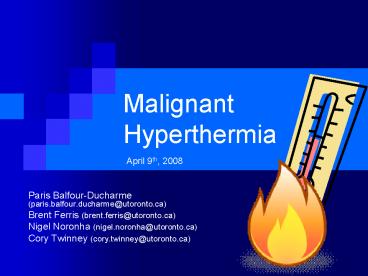Malignant Hyperthermia - PowerPoint PPT Presentation
1 / 13
Title:
Malignant Hyperthermia
Description:
Malignant Hyperthermia. Paris Balfour-Ducharme ... determined reaction to general anaesthesia, resulting in an uncontrolled ... Anaesthesia. 59(4), 364 373. ... – PowerPoint PPT presentation
Number of Views:982
Avg rating:3.0/5.0
Title: Malignant Hyperthermia
1
Malignant Hyperthermia
April 9th, 2008
- Paris Balfour-Ducharme (paris.balfour.ducharme_at_uto
ronto.ca) - Brent Ferris (brent.ferris_at_utoronto.ca)
- Nigel Noronha (nigel.noronha_at_utoronto.ca)
- Cory Twinney (cory.twinney_at_utoronto.ca)
2
What is it?
- A genetically-determined reaction to general
anaesthesia, resulting in an uncontrolled
increase in skeletal muscle respiration - - abnormal increase in body temp
- - fatal if not treated immediately
- Can be triggered by all volatile anaesthetics
(ie. halothane) and the muscle relaxant
succinylcholine
3
The Ryanodine Receptor!
- Ryanodine receptor (RyR1)
- Ca2 channel on the sarcoplasmic reticulum of
skeletal muscle cells - has two Ca2 binding sites (one high-affinity,
one low)
4
How its supposed to work
- Action potential
- propagates through T-tubule, activates
dihydropyridine receptor (DHP) - DHP releases small amount of Ca2 into the
cytosol - Ca2 binds to high-affinity RyR1 site ? channel
opens ? positive feedback - excitation-contraction coupling
- high intracellular Ca2 activates low-affinity
site and channel closes
5
(No Transcript)
6
The RyR1 Gene
- long arm of chromosome 19
- 90 mutations identified, at least 25 causal for
MH - Autosomal dominant inheritance
- Mutation clusters in central region and
N/C-termini destabilize closed state of channel - Mutation causes trigger agents (caffeine,
anaesthetics, succinylcholine) to alter affinity
of Ca2 binding sites - Closed state of channel is destabilized
7
Incidence / Risk Factors
- 15000-150000 (depending on anaesthetic)
- all ethnic groups
- twice as common in males
- majority of patients with central core disease
(inherited myopathy) are susceptible - Biopsy susceptibility testing can confirm, but
not rule out, MH in those with a family history
8
Signs/Symptoms
- Hypermetabolism
- Muscle rigidity
- Cell damage
- leakage of potassium, creatine kinase, myoglobin
- Increased ventilation/cardiac output
- ?PaCO2 ?PaO2, lactic acidosis
- Hyperthermia
- typically temperature rises by 1-2oC every 5
minutes
9
Lethal Consequences!
- Cardiac arrhythmias (hyperkalemia)
- Hemorrhage (acidosis)
- Disseminated Intravascular Coagulation (gt41oC)
- Renal failure (rhabdomyolysis/myoglobinuria)
10
Treatment
- Dantrolene sodium the only current treatment
- Reduced mortality from 80 (1960s) to lt10
(present day) - Must be administered immediately
- Mechanism
- Binds antagonistically to RyR and blocks release
of Ca2 - Ca2 will be pumped back into SR and ATP
expenditure will decrease
11
Future Research
- Dantrolene administration can be problematic due
to low water-solubility - Large fluid volumes must be infused, rapid IV
preparation is difficult - Azumolene is 30x more water-soluble and equally
potent, but has not yet entered clinical use.
12
Malignant Hyperthermia - Summary
- Definition
- uncontrolled increase in skeletal muscle
metabolism due to mutation in ryanodine receptor
(RyR) - autosomal dominant mutation causes trigger agents
(anaesthetics, succinylcholine) to destabilize
closed state of RyR channel - Release of Ca2 into cytosol causes massive
energy expenditure and hyperthermia - Symptoms hypermetabolism, hyperthermia, muscle
rigidity, respiratory/metabolic acidosis, cell
damage/leakage (potassium, creatine kinase,
myoglobin) - Diagnostic Criteria
- Respiratory acidosis (End tidal CO2 gt 55mmHg)
- Unexplained tachycardias, ventricular
fibrillation - Rhabdomyolysis (CK gt 20,000/L units, cola
coloured urine, potassium gt 5mmol/L) - Rapidly increasing temperature (gt38.8oC)Family
history - If untreated, death results from cardiac
arrhythmias, hemorrhage, renal failure and
disseminated intravascular coagulation (DIC). - Treatment Dantrolene sodium antagonizes RyR1 and
halts Ca2 efflux from sarcoplasmic reticulum
(problematic due to low water-solubility).
13
References
- Bryant S.H. et. al. The mechanism of action of
dantrolene sodium, Journal of Pharmacology and
Experimental Therapeutics, 1977 - http//jpet.aspetjournals.org/cgi/reprint/201/1/1
38 - Davis, M. et. al. Malignant Hyperthermia,
Orphanet Journal of Rare Diseases, 2007 - http//www.pubmedcentral.nih.gov/articlerender.fc
gi?artid1867813 - Krause, T. et. Al. Dantrolene - A review of its
pharmacology, therapeutic use and new
developments. Anaesthesia. 59(4), 364373. - Lenhart S.E. et. al. Modulation of the ryanodine
receptor and intracellular calcium, Annual Review
of Biochemistry, 2007 - http//arjournals.annualreviews.org/doi/full/10.1
146/annurev.biochem.76.053105.094237































